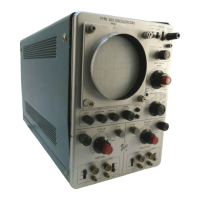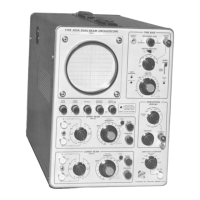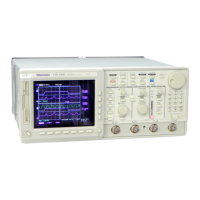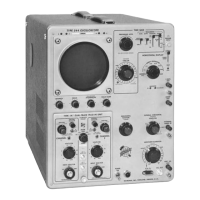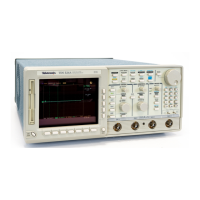The voltage reading obtained will probably be
either approximately +300 volts, or approxi
mately +30 volts. A reading of +300 volts indi
cates that the Miller stage has runup and has not
been reset, while a reading of +30 volts indi
cates that the Miller stage is not being allowed
to runup. The condition that actually exists will
depend on the type of trouble occuring in the
circuit. The two conditions of plate voltage will
be handled separately in the following para
graphs.
1. High Voltage
If the voltage at the plate of the Miller tube,
V I61 A, is high, the tube is cutoff. This can re
sult from any one of the following conditions:
(1) On-Off Diodes do not conduct, (2) Sweep-
Gating Multivibrator does not reset, (3) Hold-
Off Cathode Followers do not reset the Sweep-
Gating Multivibrator and (4) Runup Cathode
Follower does not drive the Hold-Off Cathode
Follower. The defective stage can be detected
by a series of systematic voltage measurements.
When an improper voltage reading is obtained,
this will indicate the defective stage.
Check the voltage at the grid of the Miller
tube. If the reading is only a few volts negative,
the On-Off Diodes are probably conducting nor
mally and can be eliminated as a possible cause
of the trouble. If the voltage is more negative
than —50 volts, however, the diodes are not con
ducting. Check V I52 and resistors R147 and
R148.
Measure the voltage at the output of the Time-
Base Generator (pin 3 of VI61B). If this voltage
is approximately +250 volts, the Runup Cathode
Follower stage may be assumed to be operating
correctly. If this voltage is low, however, the
stage is defective and its grid and cathode cir
cuits should be checked.
Next, measure the grid to cathode voltage of
the Hold-Off Cathode Followers, V183A and
V145B. Both of these readings should be ap
proximately —4 volts if the cathode followers
are operating correctly. If either or both of these
voltages are incorrect, check the hold-off capaci
tor and the resistors in the cathode circuits of
the two stages.
If the previous checks gave correct results, the
voltage at the grid of V135A should be sufficient
to reset the multivibrator (more positive than
—35 volts). If this is so, and the multivibrator
still does not reset, the trouble must lie in that
stage. Check the voltages at the plates of
V135A, V135B, and V I45A, and the resistors in
the cathode circuit of V135B.
2. Low voltage
Low voltage at the plate of the Miller tube
indicates that the tube is conducting quite
heavily and is not being allowed to perform its
normal runup operation. If this trouble exists on
only a few ranges of the TIME/CM switch the
trouble is likely to be an open timing resistor. If
the trouble exists on all ranges of the TIME/CM
switch, the trouble is probably due to a defective
Sweep-Gating Multivibrator stage.
To check the Sweep-Gating Multivibrator,
monitor the voltage at the junction of R114 and
R126 and adjust the STABILITY ADJUST control
for a reading of —70 volts on the voltmeter.
With this voltage, the Sweep-Gating Multivi
brator and the sweep should free run. If the
multivibrator does not switch, check the resist
ances which make up the stage.
If the voltage at the junction of resistors R114
and R126 remains relatively constant as the STA
BILITY ADJUST control is rotated, a defect in
cathode follower V145B may be causing the
stage to effectively regulate the voltage at this
point. If such is the case, the probable cause of
this condition is a shorted holdoff capacitor. If
the voltage does not adjust to the proper level,
check the resistors in the grid circuit of V135A.
For nonlinear sweep
A nonlinear sweep voltage will be generated
if the current charging the Timing Capacitor
does not remain constant. If the nonlinearity
exists at all sweep rates, a defective Miller tube
is the probable cause of the trouble. If the non
linearity occurs only at certain sweep rates, the
Miller tube or a leaky Timing Capactior is the
probable cause.
For insufficient horizontal deflection
If the horizontal trace starts at the left-hand
side of the screen, but does not extend to the
right-hand side, the Hold-Off circuit is resetting
the Sweep Gating Multivibrator before the
sweep is complete. If the sweep cannot be ad
justed to normal length with the SWP LENGTH
control R176, the resistance in the cathode circuit
of V I61B should be checked.
5-12
MAINTENANCE — TYPE 502
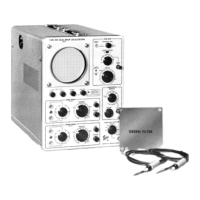
